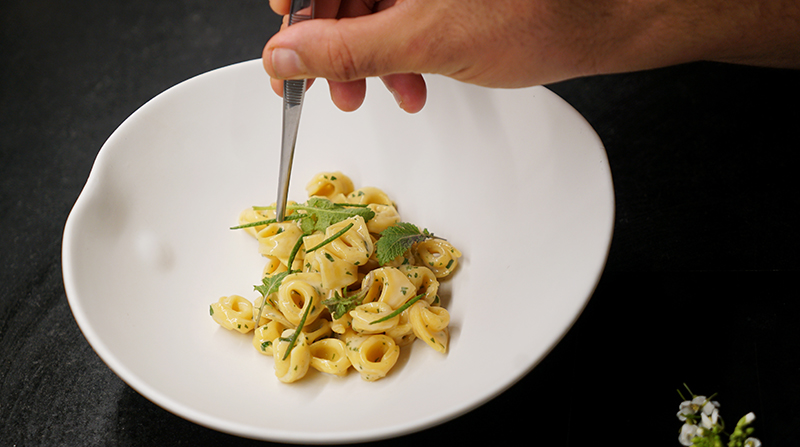

While Rome will never relinquish the triple threat of carbonara, amatriciana and cacio e pepe, it’s ready to cast off the stereotype that the classic trattoria has to be no frills, no elbow room and absolutely no service. These four new spots are turning the tables on the way you think about the Eternal City’s restaurant scene.
This budding restaurant has actually been on the block for a few years, but in 2018, a refresh revealed a larger dining space and a moody, minimalist design with a trademark open kitchen and two communal tables.
Chefs Giuseppe Lo Iudice and Alessandro Miocchi can be found center stage assembling and plating their creations: evolved recipes featuring locally sourced and foraged produce.
The dishes change so frequently, it’s best to check Retrobottega’s Instagram to see what’s on the menu — typically a five-course, prix fixe format with an à la carte option available, too. If it’s in season, be sure to order the tortelli pasta with Roman broccoli and anchovies, or the blueberry and veal shank risotto.
Be on the lookout for Retrobottega’s newest addition: Retro Vino wine bar serving bottles as carefully curated as the dishes.
If you don’t have time for a full meal, stop by Retropasta, the next-door boutique where you can pick up eight types of housemade pasta. Try the stuffed options with untraditional fillings.
If carbonara had a king, it would be Luciano Monosilio, the home-grown chef who exalted the beloved pasta dish from local recipe to coveted art form. After more than a decade commandeering the city’s fine-dining scene, Monosilio opened this Centro Storico spot to honor his roots in the local trattoria.
His pioneering take evolves the casual concept from rustic bolthole to a modern, stylish dining room with an exposed pasta lab and open kitchen. Monosilio is emphatically Roman, and he shows it off throughout the entire menu. His antipasti include incredible fritti (fried dishes) like suppli al telefono (fried rice balls stuffed with meat, tomato sauce and basil) and unexpected not-so-Roman dishes such as vitello tonnato (veal with tuna sauce and capers).
But carbs are the highlight. The pasta offerings are divided into themes: Contemporanee (contemporary), Romane (traditional Roman favorites) and Ripiene (stuffed), so you’ll be able to cash in on Monosilio’s epic carbonara, while trying some of his more unusual dishes, like fettuccella ajo, ojo e bottarga di muggine — a spin on the classic garlic, pepper and olive pasta topped with cured fish roe.
This trendy newcomer ups the ante on the typical trattoria, casting off yesteryear stereotypes in favor of clean lines and Scandinavian design — a little oasis of hygge (coziness) straight from the oven of pastry chef Sofie Wochner.
Simplicity is the overall objective at this self-proclaimed “micro bakery.” Focusing on seasonal products and smaller, local producers, Wochner’s pastries and partner Domenico Calabrese’s plates are deliciously sustainable creations, with an ethos inspired by Calabrese’s time in the kitchen of the American Academy of Rome’s Sustainable Food Project. Here, leftovers become delectable, unique dishes.
Wochner’s cinnamon twists, housemade butter (from kefir) and rye bread alone are worth the trip, but you’ll want to stay for Calabrese’s savory lunches and dinners. Each day features a different sandwich dependent on his mood, with made-from-scratch mustard aioli and Wochner’s sourdough, while evening menus (only available on weekends) often feature dishes like stracciatella (a heavenly soft cheese) with grilled, marinated artichokes and marjoram, and slow-cooked Korean pork belly.
After you dine, peruse the bakery and pick up at least one loaf of fresh-baked sourdough to bring home.
This Rome eatery from acclaimed toque Niko Romito isn’t exactly your typical trattoria. Rather, the experimental space serves as a test kitchen where chefs from his renowned cooking school can experience the bustle of a real working restaurant.
Bar, caffè, bistro and dining room, Spazio is many things, in a few different spaces that effortlessly flow into each other. The restaurant, with its contemporary industrial-meets-greenhouse feel, focuses on affordable gourmet with dishes like Rome-inspired cacio e pepe with mezze maniche pasta, and creamy pork belly with savoy cabbage and potatoes.
Spazio Pane e Caffè is the casual café side, an open, all-day kitchen serving pastries, breads, sandwiches, soups, salads and pasta dishes.
